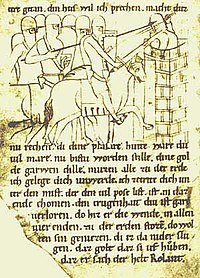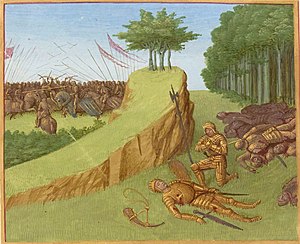The Song of Roland
![]()
This article is about the original verse epic. For other meanings of Rolandslied and Chanson de Roland, see Rolandslied (disambiguation).
The Song of Roland (French La Chanson de Roland) is an Old French verse epic written between 1075 and 1110 about the heroic end of Roland. It comprises 4002 assonant ten-syllable verses in 291 stanzas (known as laisses) and is one of the oldest works of the genre chansons de geste. Around 1900 it was stylized in France as a kind of early national epic, because of the love with which it speaks of "la douce France" (sweet France) and the prominent role it assigns to the "Français de France" (the French from the Île de France) in the multi-ethnic army of Emperor Charlemagne.
The epic is about Charlemagne's war campaigns against the "pagans", i.e. against the Islamic Saracens coming from North Africa, who had dominated southern and central Spain since their invasion of Europe in 711/12.
The Song of Roland was composed or written down, but perhaps only dictated and/or often recited by an otherwise unknown Turoldus, of whom the last verse says, not exactly clear, that he "declined" the work (Ci falt ("here ends") la geste que Turoldus declinet). It is unclear whether this is a compilation of older songs. Various manuscripts of the song were discovered in the 1830s. An older version comprised about 9000 verses.
The work is preserved in seven complete manuscripts and three fragments. The most important are the so-called Oxford manuscript (Digby 23), which apparently originated on English soil in the second quarter of the 12th century and whose language is strongly coloured by the Anglo-Norman dialect, and a 14th century manuscript preserved in Venice, which, however, contains only 3846 verses closely related to the Oxford version (Marc. 225). This is followed by an otherwise untransmitted account of the siege of Narbonne, after which the plot follows the rhymed versions.
The plot
The Song of Roland comprises two larger parts: in the first three fifths (verse 1-2396) Roland is clearly the protagonist, in the last two (verse 2397-4002) rather Charlemagne.
At the beginning of the plot, the latter has conquered almost all of pagan Spain in seven years of war, except for Saragossa. Its king Marsilie, "who serves Mohammed and invokes Apollo", now offers him submission and conversion to Christianity - but both only in pretence, in order to achieve the withdrawal of the Frankish army. Charles gathers the Council of Barons, in which his brother-in-law advises Ganelon to accept the offer, while his nephew Roland, who is also Ganelon's unloved stepson, wants to continue the struggle. Charles, already old and weary of war, joins Ganelon, whereupon Roland, with hurtful irony, proposes him as emissary.
The offended Ganelon seeks revenge. He goes to King Marsilie, to whom he presents Roland as a warmonger, without whose removal there will be no peace. Marsilie is therefore to attack the rearguard of the departing Frankish army with a superior force; Ganelon wants to ensure that Roland is their commander.
Everything happens as planned. When Roland, with his twelve friendly knights as sub-leaders, notices the ambush, he is urged by his prudent friend and brother-in-law-to-be Olivier to use the bugle Olifant to call the Frankish army to help, but proudly refuses. Only when the situation was hopeless after the first wave of attack had been repulsed with heavy losses, did he blow the horn on the advice of the pugnacious Bishop Turpin. After the second wave (whose heroic battles are again lovingly detailed) only Roland is left. After he too is mortally wounded by a hail of spears and arrows, the pagans flee, believing they can hear Charles's army. Roland dies on the battlefield in the pose of the victor, facing Saragossa. The archangel Gabriel and two other angels escort his soul to paradise.
Charles, who has indeed rushed over, pursues and destroys the pagans, whose remnants flee to Saragossa with the badly wounded King Marsilie. There a huge army of pagans is just arriving, led by "Admiral" Baligant of "Babylonia", whom Marsilie had asked for assistance years before. But Charles destroys this army as well, not without meeting Baligant himself, who is still spry despite his age, in the thick of battle and defeating him in a long duel with the help of an angel. After the capture of Saragossa and the forced conversion of its inhabitants, Charles returns to his residence in Aachen.
Here he must bring the news of his death to Roland's fiancée, Aude, which also causes her death. He now wants to have Ganelon tried, but thirty relatives protect him, including Pinabel, who wants to represent him in the judicial duel. Only when Thierry, the young brother of the Count of Anjou, offers to fight for the just cause and defeats Pinabel with God's help, can Charles punish Ganelon and his family. That same night, the Archangel Gabriel appears to him and invites him to help King Vivien, who is besieged by pagans in his city of "Imphe". Karl cries and pulls his beard - but one suspects: he will go.

Roland storms the temple of Mahomet. Illustration from the Heidelberg manuscript of the Middle High German adaptation (Cod. Pal. germ. 112, P, fol. 57v), end of 12th century.
Historical background
The plot is based on a military campaign that Charlemagne led against the Islamic Saracens in Spain in 778. The occasion was the request for help by Sulayman ben al-Arabí, governor in Saragossa, against his master, Emir Abderrahman of Córdoba, the goal of securing the (northeastern) Spanish Marche, which was not accomplished until later.
The campaign was abandoned after initial successes. Saragossa, whose gates, contrary to Charles' expectations, did not open after the political-military situation had clearly turned in favour of the Emir, was besieged for months without success. Disease and an increasing lack of food did the rest. It is also possible that a renewed Saxon uprising was preferentially to be put down.
Retreating via Pamplona, Charles released the Basque-Navarrese and Christian city for raid and plunder by his forces. There was a bloodbath and further, expected effects on the population. While continuing their journey, the Frankish rearguard was ambushed at the Pyrenean town of Roncesvalles (Navarre). However, it was not the Saracens who laid this ambush, but the Basques, who were intent on retaliation. Einhard, for example, wisely concealed these circumstances in his biography of Charlemagne in favour of his emperor.
The leader of the rearguard was possibly Hruotland (Frenchized Roland), attested as Roland of Cenomania, Margrave of the Breton Marches of the Frankish Empire. With him fell Count Eginhard and Count Anselm on 15 August 778 (→ Battle of Roncesvalles). The Song of Roland turns this debacle of the Franks into a heroic deed of salvation, for which the author of the song was possibly inspired by the Reconquista.

Death of Roland. In: Grandes chroniques de France by Jean Fouquet, Tours, ca. 1455-1460.
Questions and Answers
Q: What is The Song of Roland?
A: The Song of Roland is an epic poem based on the Battle of Roncevaux in 778 during the reign of Charlemagne. It is the oldest surviving major piece of French literature.
Q: In what time period was The Song of Roland popular?
A: The Song of Roland was popular from the 12th to 14th centuries.
Q: When was the earliest version of The Song of Roland written?
A: The earliest version of The Song of Roland began around 1040.
Q: Was The Song of Roland a written or oral tradition?
A: The Song of Roland was written to be performed, possibly to music.
Q: Who wrote The Song of Roland?
A: The author of The Song of Roland is unknown.
Q: What is the literary form of The Song of Roland?
A: The Song of Roland is the oldest example of the chanson de geste, which was a literary form popular between the 11th and 15th centuries.
Q: How many poetic units are there in The Song of Roland?
A: There are 298 poetic units called laisses in The Song of Roland, which has about 4,000 lines of poetry.
Search within the encyclopedia